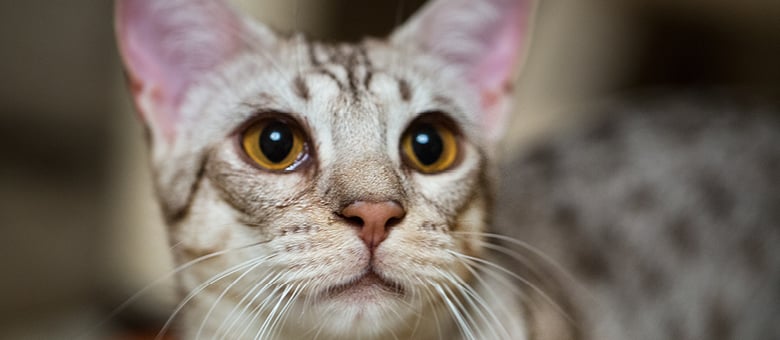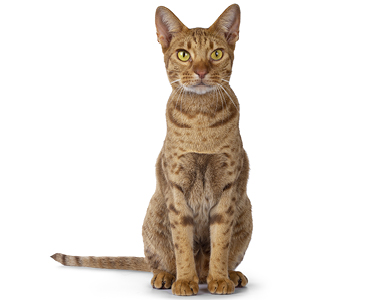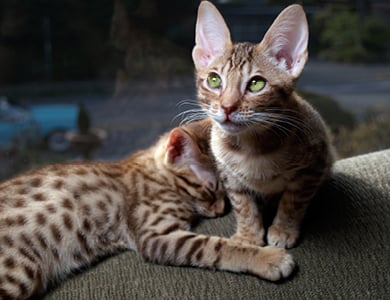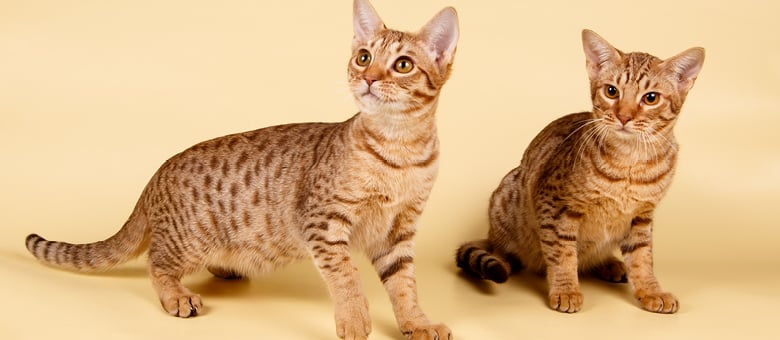The name ocicat is derived from that of the small wild cat native to Central America called the ocelot, also known as the dwarf leopard because of its spotted coat that’s almost identical to that of the Asian leopard. When looking at the ocicat’s coat, it’s easy to understand the inspiration behind its name.

Origins
The ocicat is a relatively recent breed that was developed in the U.S. in the 1960s. A breeder trying to create a Siamese tabby point crossed a female Abyssinian-Siamese metis with a male Siamese chocolate point. Against all odds, one of the kittens was born with an ivory-coloured coat with tiny gold spots. The astonishing colour and spots sparked a desire to create an entirely new breed, which involved crossbreeding Abyssinians, Siamese, Orientals, Egyptian maus and American shorthairs. During the course of the crossbreeding, the ocicat’s morphology saw its genetic code expand, allowing the breed to develop an athletic appearance.
The breed was not officially recognized until 1986. Although it became hugely successful in North America, it is still not especially popular in Europe. Since then, no further crossbreeding—including with Abyssinians—has been authorized.

Morphology and appearance
The ocicat is extremely well proportioned. It is long and tall, standing high on its legs. It has a slightly triangular head compared with its Oriental and Siamese ancestors. Its large almond-shaped eyes come in all colours except blue. Although it has a strong muscular build, it is not heavy. Its weight ranges from 3 to 6 kg, depending on the sex. It has a characteristically short, silky coat that lies close to the body. The hair is short, but long enough to have alternating light and dark bands known as ticking. Each hair, except on the tip of the tail, has several bands of colour. Its coat comes in a spotted tabby pattern: several round spots across its entire body, from the shoulders to the abdomen, all the way to the tail (which is darker). It also has a ruff around its neck.
Level of maintenance (grooming)
Ocicats are considered fairly low-maintenance cats, given their short hair. They nevertheless require weekly brushing, which can be increased during shedding season.
Behaviour
Although they look like small wild cats, ocicats make good pets. Like all other domestic cats, they do not result from crossbreeding with strains of wild cats, which makes them generally more easy-going than the popular bengal and savannah cats. Despite earlier crossbreeding with Siamese, they do not have the same type of meowing. The cats’ size and strength make them highly energetic. They are often very curious and easily amused, and are gentle and affectionate with people that they trust. A kitten will not necessarily have the same temperament as another from the same litter. Even though they may have grown up in the same environment, each kitten will react and interact in its own way. Some will behave very boldly and others will be quite timid. Ocicats adapt well to apartments or houses, with large or small families. It’s up to you to choose carefully and get good advice on your choice to ensure that you and your cat enjoy a long and happy life together.
Unusual facts
The ocicat is a breed that evokes the elegance and charm of a wild cat because of its spotted colouring, but has the temperament of a domestic cat. It’s difficult to understand why the ocicat hasn’t had at least the same success as the Bengal or Savannah cat, resulted from crossbreeding with wild cats, since it’s much more likely to adapt to our way of life.



